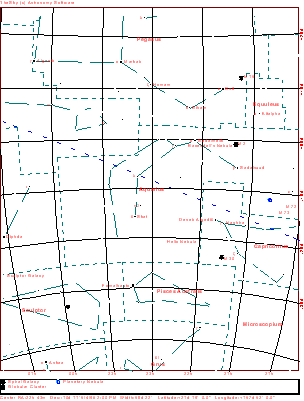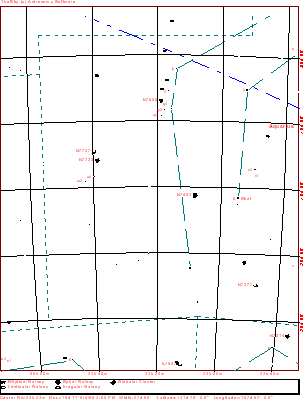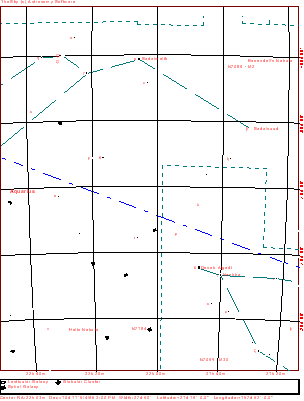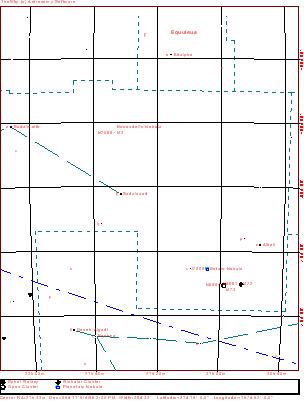
| Home | Deepsky Atlas | TheAstronews | Links | Solar System | ||||||

Hawaiian Astronomical SocietyConstellations: Aquarius -- Water Bearer |
||||||||||
Each map can be clicked on to produce a 909x1199 version of it. They sport red labels, which look good on screen, but which disappear when used with red flashlights. Each map, therefore has a second link to a map better suited for printing in a graphics program, and using in the field. While they are quite large, they are all about 20-35k, and so are easy to view at today's modem speeds. The first map is a wide area view of the constellation, suitable for naked eye browsing. The next views are binocular width, showing stars to mag. 10, and labeling deepsky objects to magnitude 12.

Click the map for a 909x1199 version of the above. Click here for a map better suited for use in the field.

This is the north-east section of the constellation. The map displays stars to magnitude 10, and deepsky objects to magnitude 12. Click here for a map better suited for use in the field.

Click here for a map better suited for use in the field.

Click here for a map better suited for use in the field.
 34k JPEG M2 (NGC7089, Bennett 127) is a mag. 6.5 globular cluster, located 11° SSW of Enif (in Pegasus). 13' in size, M2 is a good object in a rather barren region of sky. Dreyer describes it as bright and large, brighter toward the middle, and very, very rich. 34k JPEG M2 (NGC7089, Bennett 127) is a mag. 6.5 globular cluster, located 11° SSW of Enif (in Pegasus). 13' in size, M2 is a good object in a rather barren region of sky. Dreyer describes it as bright and large, brighter toward the middle, and very, very rich.
|
 15k JPEG NGC7293 (Bennett 129, Best 5, Caldwell 63) is the Helix Nebula, a relatively large (12.8'), faint planetary nebula, dark skies and low power tease this object from the sky background. 15k JPEG NGC7293 (Bennett 129, Best 5, Caldwell 63) is the Helix Nebula, a relatively large (12.8'), faint planetary nebula, dark skies and low power tease this object from the sky background.
|
  NGC7009 (Bennett 126, Best 4, Caldwell 55) is called the Saturn Nebula. It is a planetary nebula described as very bright (mag. 8), small (1.7'), and elliptical. It is 1.3° west of Nu Aquarii. Dreyer cansiders this a showcase object, giving it three exclamation marks. The first image is taken by the Nordic Optical Telescope (39k JPEG), and is taken from Bill Arnett's Web Nebula. The second is by Pedro Ré (18k JPEG), and looks more like the visual view through a telescope. NGC7009 (Bennett 126, Best 4, Caldwell 55) is called the Saturn Nebula. It is a planetary nebula described as very bright (mag. 8), small (1.7'), and elliptical. It is 1.3° west of Nu Aquarii. Dreyer cansiders this a showcase object, giving it three exclamation marks. The first image is taken by the Nordic Optical Telescope (39k JPEG), and is taken from Bill Arnett's Web Nebula. The second is by Pedro Ré (18k JPEG), and looks more like the visual view through a telescope.
|
 13k JPEG M72 (NGC 6981, Bennett 125) is a mag.
9.4, 6' globular cluster, located in the south-west corner of the constellation, about 3.3° SSE
of epsilon Aquarii. Not outstanding in any way, but Dreyer stresses it is easy to resolve. Photo by
Scott Schell with the SUNY C14 and an ST-6 CCD camera. 13k JPEG M72 (NGC 6981, Bennett 125) is a mag.
9.4, 6' globular cluster, located in the south-west corner of the constellation, about 3.3° SSE
of epsilon Aquarii. Not outstanding in any way, but Dreyer stresses it is easy to resolve. Photo by
Scott Schell with the SUNY C14 and an ST-6 CCD camera.
|
 11k JPEG M73 is an asterism of four
stars located 1.3° east of M72. Photo by Scott Schell with the SUNY C14 and an ST-6 CCD
camera. 11k JPEG M73 is an asterism of four
stars located 1.3° east of M72. Photo by Scott Schell with the SUNY C14 and an ST-6 CCD
camera.
|
If you have any questions about the Hawaiian Astronomical Society
please
(link requires javascript).